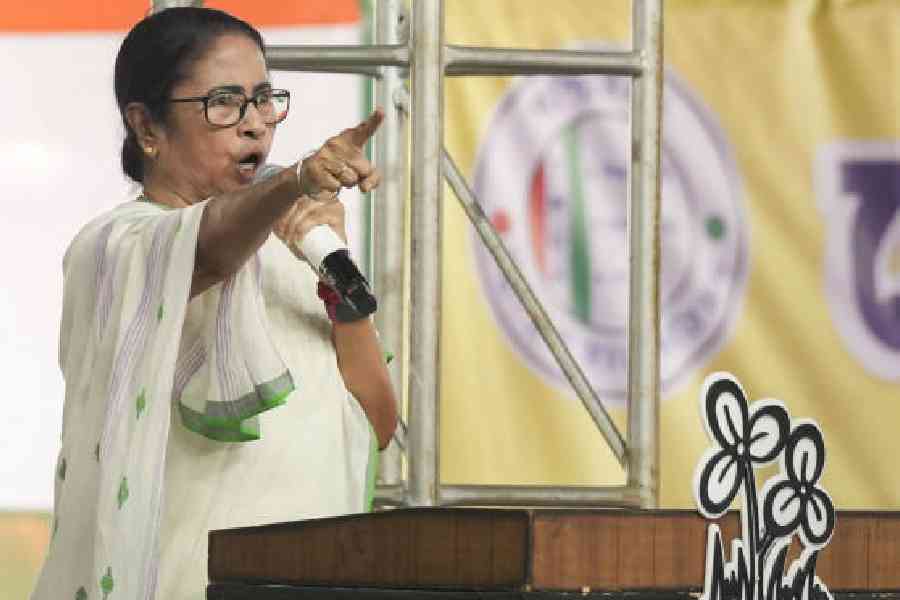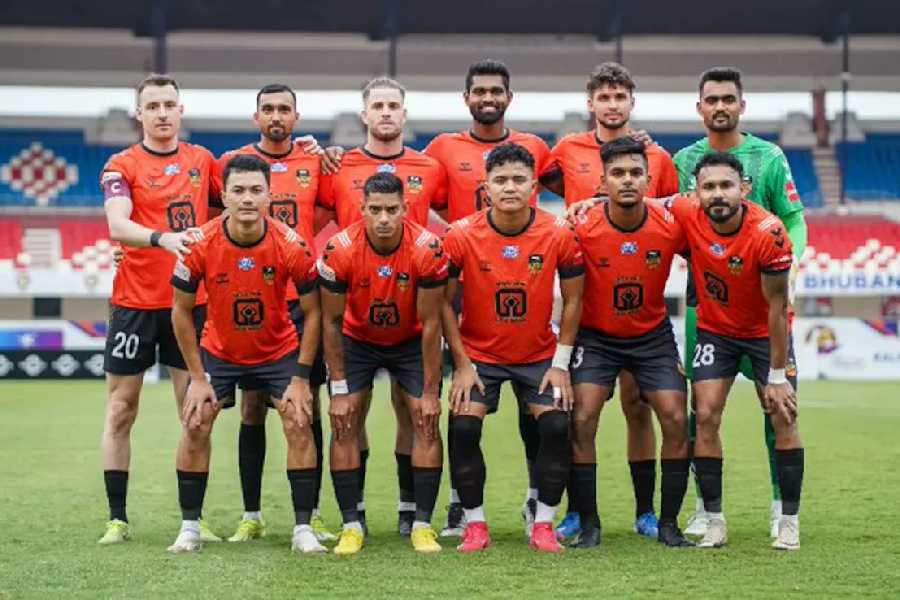
It’s been 11 years since she got herself a ground-floor apartment in Dum Dum Park, yet Jhulan Goswami keeps such a low profile that not many except her immediate neighbours know where she stays. But locating her house becomes easy when, on receiving a call from us, the highest wicket-taker in women’s cricket offers to wait for us on the street leading to her house.
“Ei, edike,” is the shout out and wave from the 5 ft-11 inch frame, that was loping down the Lord’s greens in the ICC Women’s World Cup final just a month back (July 23).
Ten years ago, when Jhulan had returned from Johannesburg with the ICC Women’s Cricketer of the Year award, Chak De! India — championing the cause of women in sport — was the talk of the town and someone in the welcoming mob had shouted, “Chak De Jhulan”. She was quick on the draw: “Please don’t compare me to the Chak De! girls. I am a player, not a heroine.” Call her the Chakdah girl, instead.
To understand Jhulan, now 34, one has to go back to the two rooms with a tin roof in Chakdah, 65km north of Calcutta, where she grew up with two younger siblings and her parents. She played most of her cricket with cousins at her aunt’s place about 10 minutes away from home.
“I have lost count of the number of window panes and showcase glasses we broke. The ball sometimes even landed in the neighbour’s kadai on the boil, spoiling their lunch, and Ma or my aunt
had to go and cook afresh for them!” says Jhulan, adding, “It wasn’t our fault. This is what happens if you don’t allow children to play outdoors.”
Playing with boys fuelled her need for speed. She, one of two girls in the group of guys, was in Class VIII-IX then. But often, boys from other localities would refuse to play if there were girls in the team. “But my friends would refuse to play without us.” But she had to play on their terms. “They would not let me bowl, bolto ‘Tor ball aaste hoy’. That’s how I developed this urge to bowl fast,” says Jhulan, who for a number of years clocked 120kph on the speed gun making her the world’s fastest.
CAMBIS TO DEUCE
The graduation from cambis ball (local name for canvas ball) to “deuce ball cricket” (a popular pejorative for leather balls under the brand Duke’s) might not have happened had Jhulan not accompanied a girl from the neighbourhood to a coaching centre in Vivekananda Park, in south Calcutta.
“It was the eve of the Women’s World Cup final. They asked me to accompany them to the ground as they were all busy with the preparations there.” New Zealand and Australia eves were facing off and Jhulan, then 14, stepped onto the Eden Gardens greens for the first time — as a ball girl at their nets. The next day, she watched awestruck from the galleries as a full house cheered the likes of Belinda Clark (the first player to score an ODI double century), Debbie Hawkley and Cathryn Fitzpatrick (whose record of highest ODI wickets she would eventually break) in action. “Seeing such high-quality women’s cricket for the first time, it occurred to me that I too could take up this sport as a career.”
But her opening spell at the coaching centre was a downer. “Sir (Swapan Sadhu) asked me what I could do. I said, ‘Everything.’ He asked me to bowl. Three weekends went by and I bowled and bowled. Finally, in exasperation, I told him, ‘Sir, aami kintu batting-o pari.’ That fell on deaf ears. The girls I bowled at would play only forward defensive shots. I used to think what kind of batting was that! Ki re bhai, era marey na kyano? So finally when I got to bat, I played some attacking shots. Immediately Sir told me to get out of the nets. ‘Eta tennis ball cricket noy! You have to play proper cricketing shots here’, he thundered.”
Meanwhile, resistance was building up at home. No one wanted her to play cricket. There was no future. “Relatives asked why I was being allowed to travel to Calcutta on my own. Jodi kichhu hoye jaye! We were not so smart in those days. Coming to Calcutta was a big deal.” She still fought and had her way till the opposition got too much. Finally, she informed Sadhu that she would not be able to continue practice and stopped making the journey to Calcutta.
It was then that Sadhu, unannounced, landed up one day in Chakdah. “That was a blessing for me. Once he spoke to my family things became smooth at home.”
She would report dot at 7.30am to Vivekananda Park. She would take the 5.05am Krishnanagar Local and reach Ballygunge station on the Sealdah south route. From there she would take a bus. “The first day I came alone I was dead scared. Especially on the bus. Unlike rail stations, bus stops are not marked by name. If I got off at a wrong stop, I knew I could not find my way.”
The coach did not tolerate late comers. “Coming late meant no practice for the day. He would hurl the ball at you if you did badly in a match....”

BOWL TO THE BOYS
Rising through the under-19 ranks to the Bengal team, Jhulan’s breakthrough came in the match she played for East Zone versus Air India in the Rani Jhansi Trophy. Though East Zone lost to the star-studded Air India, Jhulan’s fiery spell (3 for 13 in 10 overs) caught the eye of opposition captain Purnima Rau, the then India captain, who sought her out for a chat post-match. Within a few months, in 2000, Jhulan was offered a contract by Air India on a sports promotion stipend. She was made permanent six years later.
“It gave me financial security and a chance to share the dressing room with veterans like Rau, Anjum Chopra and Anju Jain. At Air India, there was no discrimination between men and women. At the MIG cricket ground in Mumbai, both sides trained together. I could bowl in the nets at Sameer Dighe, Praveen Amre, Narendra Hirwani...”
Air India had a sports scholarship for the local under-19 boys. “We used to play with them regularly. If we defeated them they came back ferociously. There was no inch spared for playing against girls. I too loved intimidating older boys with bouncers! Those matches gave me a lot of confidence.”
Yes, there was a lot of hardship and discrimination in women’s cricket — unreserved train tickets, shoddy accommodation, second rate grounds…. Diana Eduljee, a member of the current Committee of Administrators for cricket in India, has spoken about how women were asked to pay Rs 10,000 for taking part in the 1982 World Cup. “I have heard even Bengal players were asked to pay Rs 500 as minimum transportation charges on getting selected. I had left for Air India then,” says Jhulan.
But the champion from Chakdah is not one to complain. “Women’s Cricket Association of India, which used to run the game then, had neither the funds nor the infrastructure like Board of Cricket Control in India (BCCI). I will not blame them. Despite all constraints, they took women’s cricket forward.”
The reins passed to BCCI once the parent body International Women’s Cricket Council (IWCC) merged with International Cricket Council (ICC) in 2005.
THE FIRST WICKET
Jhulan’s ODI debut was in Chennai versus England under Anjum’s captaincy in January 2002. “I was plagued by self-doubt: did I belong at that level? My biggest fear was staying wicketless. I was telling myself, I must get one wicket so that after this if I didn’t play any other match I would still not have a regret,” says the pacer, who now sits tall at the top of the heap with 195 scalps. “As soon as I got one wicket in the third over or so, the pressure eased.” The very next match she was adjudged Woman of the Match. Jhulan had arrived.
Lots of wickets, lots of milestones followed. A record 10 for 78 in a Test match against England in 2006, being named Player of the Series for her haul of 15 wickets in two Tests in a historic away series win, ICC Women’s Cricketer of the Year in 2007, the India captaincy in end-2008….

MITHALI & SHE
The two pillars of the current team are bound by statistics and more. “Mithali (Raj) had taken the catch at slip when I got my first ODI wicket (of Caroline Atkins). She had held the catch for my 100th wicket too!”
When Jhulan started playing under-19 in 1999-2000 for East Zone, South Zone’s Mithali had already donned India colours. “She was the only one in our age group who got picked straight from under-19. I stared open-mouthed when a teammate pointed her out to me before a match. Ei boyeshe India khelechhe!”
When Jhulan got the India ODI cap, Mithali was the vice-captain. They debuted together in Tests at Lucknow, in 2002. “I loved the way she created a mental zone before a match. She can control her emotions. After so many years, we read each other well. If she does not like the way I am bowling she may not utter a word, but I can make out.”
When the team went to England later in 2002, Mithali was batting at 130 or so when Jhulan came out. “In those days, she used a tremendously heavy bat. She told me she was too tired to carry on. We were still a long way behind England’s score. It was the day after August 15. I pointed to the fluttering Tricolour and said we had to carry on for the country.” When Mithali finally got out at 212, the highest individual score in women’s cricket, the two had stitched a partnership of 157, a record for the seventh wicket, with Jhulan at 62. “That was my first Test 50.”
Playing cricket and playing pranks have been two sides of the coin for the two. On being coaxed, Jhulan tells the story of Mithali interviewing her over phone, posing as a BBC reporter! “That was 2005. The match in Silchar against England got over in half a day. There was nothing to do. They must have plotted it as a timepass! The call came to my hotel room. The voice was speaking in full accent! I had got five wickets in the match. So I did not suspect anything and answered all the questions. BBC was a huge deal then. In my excitement I even told folks back home.... But when I walked into their room, the assistant coach Amita Sharma burst out laughing... I did not speak to Mithali for two days!”
Both have played under each other’s captaincy. “We have always divided responsibilities. When I took over as captain (from Mithali) in 2008, I asked her to take care of the batting department as she was our best batter and I would guide the bowling. We have never let personal egos come in the way. The team does not belong to anyone, it is India’s.”

IF WE WON... THE LORD’S BALCONY!
And that team has just done the country proud.
“Playing a World Cup final at Lord’s is any cricketer’s dream. The day the 2017 Cup schedule was released we discussed amongst ourselves that if we played well we could play the final at Lord’s. And if we won we would hold the trophy on the Lord’s balcony! It was an extra motivation,” she says
Lord’s was always special to Jhulan. In 2001, she had visited England on a 15-day Air India tour to play against counties. “That was the first time I walked into Lord’s, as a visitor. So awed was I that I had plucked a blade of grass from the ground as a souvenir. I had never thought I would be able to play at Lord’s, and that too a World Cup final!”
She commends the way the BCCI has focused on women’s cricket in the last couple of years. “We were given central contracts. Tour fixtures were planned well in advance so we got adequate preparation before the World Cup.”
The England & Wales Cricket Board (ECB) too had provided a great build-up. “We had reached England early for preparations. Wherever we went, in shopping malls and so on, there were countdown clocks — one for the (men’s) Champion’s Trophy and the other for the Women’s World Cup. Awareness was so high that tickets to the final got sold out while the tournament was in the league stage.”
None except keen followers of the women’s game would know that the India eves had reached the World Cup final in 2005 as well. What has changed this time for the wave of mass adulation, so long restricted only to the men’s sport, to surge match by match as they progressed in the tournament and finally sweep Bollywood stars, the Prime Minister and the man on the street off their feet in India?
“The 2005 event was run by IWCC. They did not have the funds to even televise matches. In our country, nothing happens unless it happens on TV. Online ball-by-ball score was just starting but few had access to the Net. So people did not even get to know we were playing a World Cup final somewhere.”
This time, the ICC, she says, deployed the same high-level team of officials to administer both Champion’s Trophy and the Women’s World Cup. “There was live telecast. For the few matches that could not be telecast live, there was live streaming — not with four-five cameras but with 12-14 cameras. Digital and social media also played a huge role.”
Jhulan bowled her heart out in the tournament, peaking in the final with figures of 3 for 23. One does not want to discuss the heart-breaking turn of events in the final except to ask if they could see from the dugout why captain Mithali could not dive to avoid getting run out and arrest the avalanche of wickets. “She said her (boot) spikes had got caught mid-pitch,” she replies quietly.
The result not-withstanding, the team’s performance fired the nation’s imagination. Even now, Jhulan is attending one felicitation after another.
FOR THE LOVE OF LUCHI
Jhulan has got multiple offers to play Big Bash, the T20 league in Australia. The first season, in 2015-16, the BCCI did not allow any player to play overseas leagues. The next year, she had a minor injury. “I did not want to risk aggravating it. They called me this year too. I am grateful that they still do. But at this stage, I want to prolong my India career, keep myself fresh for the country. Maybe financially it would be a loss, but this is my priority now. Had such offers come four years ago I would surely have signed up.”
Jhulan’s jovial mother Jharna, so long being heard cooking in the adjacent kitchen, now makes an appearance with two plates of luchi-torkari for the two of us. “Did you think you would escape without a meal?!” she laughs affectionately. “I love luchi but a player’s diet does not allow it. I have just come back, so I can indulge myself for a day,” Jhulan smiles, breaking the thin crust of one.
One refrains from asking The Question: will Jhulan be around for yet another crack at the World Cup four years later? That’s her Mission Possible for sure, but for now let her enjoy that rare luchi.
I had finally got a special gift after years of coaching
Swapan Sadhu

I started this camp in 1984 with three girls, going from school to school seeking pupils to teach the game for free. Passers by would taunt me with comments like: "Oi dyakh, meyeder Gavaskar-Kapil banachchhey." Jhulan came to me in 1997. In those days. there were four bamboo poles at four corners of the pitch. The girls would come, mount the net, drag the roller from a room in the middle of the park to roll the pitch. I also taught them to lay the mat on the pitch. Only after all this would practice start. At the end of the session, they would have to dismantle everything.
When Jhulan first bowled at the nets, my heart had skipped a beat. Such a long rhythmic run-up, straight arm delivery - I thought I had got finally a special gift after years of coaching. I did not let her bat immediately. I knew bowling would be her thing.
Jhulan's best quality is her stubbornness and never-say-die attitude till the last ball. Because of her perfect rhythm, spot jump and balance, she has never fallen after delivery, something you see some star male pacers do. This is the secret to her longevity. How many fast bowlers will you find bowling at the international level for 15 years with an average under 23? What had given me hope about her from the start was how restless she was. For cricket, you need that. Those who are calm are good in mental sports like chess or archery.
She was heart-broken when she was refused selection to the sub-junior Bengal team for being just a few days over-age. I egged her to go for the junior trials and prove herself against older players. In her very second year for East Zone, she put in sterling performance and got a call from Air India.
She remains 100 per cent obedient to her coach till this day. For the first couple of matches in this World Cup, she was going wicketless. One day I got a call from a +44 number. I do not usually take calls from unknown callers and ignored it twice. The third time, when I hesitantly answered, there was an agitated Jhulan at the other end: "Sir, amar phone dhorchhen na kyano? Dekhchhen, kono match-ey amar wicket nei?" I calmed her down and had a long chat. The way my girl bowled the rest of the tournament is for the world to speak about. I will say nothing more.
(Swapan Sadhu is Jhulan's first coach at Vivekananda Park, where Calcutta's only all women cricket coaching camp is held)
My daughter
Jharna Goswami

She has always been cricket-crazy. Even when she walked she would rotate her arm, delivering an imaginary ball. It is true we didn't support her passion at the start. Who knew girls played cricket! She is the eldest of three siblings. Her brother Kunal and sister Jhumpa also love sports. On holidays, they still leave for the local playground with bat and ball.
Jhulan used to come home after practice in Calcutta around 3.05-10pm. If ever she did not return past 3.15pm, I would go out and start on the street. Without cellphones, I could do nothing but worry. Her father worked with Indian Airlines. So when she got the job from the same company, she proudly told him: "Ebar theke ami tomar pass-ey jabona, tumi amar pass-ey jabey."
Her grandmother was very modern in her outlook. She never bothered that Jhulan was always in trousers. "Sari porle khelbe ki kore," she used to say. Jhulan can't cook much but makes me a cup of tea now and then.
It doesn't bother me that she hasn't settled down. Once a family's responsibilities fall on one's shoulders, love for sports goes out of the window. I have seen that happen to girls senior to her. I am happy that she is happy doing what she loves.
We were so devastated after the World Cup final that I could not cook that night. We ate whatever the next-door neighbours brought for us.
There was another time when I could not cook for three days in a row - after Jhulan became ICC Women's Cricketer of the Year. There was such a rush of people and press in our two rooms that I had to come out to the streets. Cup niye phirle ebar-o tai hoto.
She loves simple food - fish-rice, potato fries, shukto… I have never seen her play in a stadium or live on TV. I get too tense. When she got the Arjuna Award from the President, that is the only time that I went with her. She travels so much now that she does not find time to go to Chakdah so I come and stay when she is here.
She is an inspiration

Arpita Ghosh
When I joined Swapan sir's camp, Jhulandi was already here. She used to come from so far but never have we seen her get late and miss practice. She still comes to the camp whenever she is free and sits with Sir, watching the girls practise. If she spots a defect in any bowler, she points it out to us. She is an inspiration to the trainees but they see her as a star. They have not seen her hard work and struggle. After 10 years, a pace bowler's shoulder, hamstring, calf muscle start showing signs of wear and tear. But Jhulandi has carried on for so many years. Hats off!
(Arpita Ghosh is the coach of the under-19 Bengal women's team)










